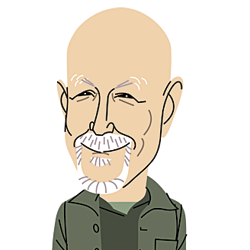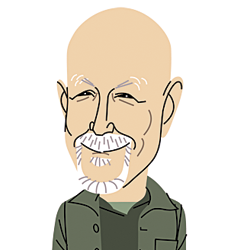|
Trade Show Bob
"Speak" to your audience

 recently attended the AAOS (Orthopedic Surgeons) Expo in New Orleans. I saw some amazing exhibits, and I learned some key facts about "speaking" to your audience. The doctors that attend AAOS are a unique and interesting breed. In a lot of ways they have more in common with auto mechanics than they do with other kinds of doctors. recently attended the AAOS (Orthopedic Surgeons) Expo in New Orleans. I saw some amazing exhibits, and I learned some key facts about "speaking" to your audience. The doctors that attend AAOS are a unique and interesting breed. In a lot of ways they have more in common with auto mechanics than they do with other kinds of doctors.
As I watched the in-booth videos, saw the surgeons handling the equipment on display, and observed how they interacted with the exhibitors, three things became clear:
1. They were a very hands-on bunch
2. They didn't get tired standing up all day – that's how most of them work during surgery.
3. Their jobs are very physical. They pound and pull with great force (a little creepy when watching the videos, I'll admit).
They loved to touch, feel, and pick up the devices, caressing the tools to get a better sense of how they balance in their hands. They were frustrated by tools they couldn't handle, either behind glass cases, or depicted only graphically. In fact, I saw more than one exhibitor "un-bolt" his showcase, so the doctors could handle the devices on display.
They stand up a lot, and they have the power to engineer their operating environment exactly to their liking. Yet often times, exhibitors would choose low height tables rather than taller counters when displaying their devices – which would have been appropriate for sit-down meetings, but made the doctors bend over to touch and handle the displayed products.
The demos that were most successful and that the doctors found most exciting were more like pre-school toy rooms than sterile operating theaters. One exhibitor even created an enclosed, glass-walled "demo room" that looked more like the day care center at IKEA than an organized surgical display room. The doctors loved it. They could bang away and pound things to their hearts' content.
The lesson here is that the successful exhibitors learned how to tap into the key driving behaviors of their audience, "speaking" to them in subtle ways that made them feel comfortable and energized in the exhibit.
Each industry, and each vertical market attracts a particular audience, each with its own set of driving behaviors. For example:
 From the food industry: These attendees take pride in their tasting skills. We once did a "guess what's in the recipe" contest using chili. Visitors were invited to taste the chili, then try to guess the ingredients. We talked with lots of "experts" that day about spices and ingredients – which we happened to sell. From the food industry: These attendees take pride in their tasting skills. We once did a "guess what's in the recipe" contest using chili. Visitors were invited to taste the chili, then try to guess the ingredients. We talked with lots of "experts" that day about spices and ingredients – which we happened to sell.
 From the computer industry: Technical people (of all sorts) are driven by "discovery," and want to add their mark to the final solution. They tend to often mistrust a "gift-wrapped" solution. From the computer industry: Technical people (of all sorts) are driven by "discovery," and want to add their mark to the final solution. They tend to often mistrust a "gift-wrapped" solution.
 From the construction and repair industry: The National Apartment Association taps into the competitive nature of appliance repairmen, holding an "Olympic-style" challenge (who can fix the dishwasher fastest) right on the trade show floor. From the construction and repair industry: The National Apartment Association taps into the competitive nature of appliance repairmen, holding an "Olympic-style" challenge (who can fix the dishwasher fastest) right on the trade show floor.
 From the food industry: Our customers and prospects were very competitive with each other, so we had to design private meeting spaces within our exhibit. Collaborative tactics, such as testimonials and endorsements, just didn't work for us. From the food industry: Our customers and prospects were very competitive with each other, so we had to design private meeting spaces within our exhibit. Collaborative tactics, such as testimonials and endorsements, just didn't work for us.
 From the medical device, education, and security related industries: This industry is just the opposite. These groups are very collaborative, and they love to share their successes with each other. From the medical device, education, and security related industries: This industry is just the opposite. These groups are very collaborative, and they love to share their successes with each other.
Little things can make a big difference, like choosing the right height for a table in your exhibit, allowing visitors to be hands-on, keeping things hands-off (for a different group), or planning a hospitality "party" vs. doing individual entertaining.
The point here is you need to take the time and observe your audience in action, and understand the key traits and behaviors that open their ears to your messages. If you can uncover and leverage these driving forces in your exhibit planning, you'll definitely be speaking loud and clear.
|
Bob Milam, independent industry consultant, is a former EXHIBITOR Editorial Advisory Board member and a past All-Star Award winner, and a current EXHIBITOR Conference faculty member. tradeshowbob@gmail.com |
|




 recently attended the AAOS (Orthopedic Surgeons) Expo in New Orleans. I saw some amazing exhibits, and I learned some key facts about "speaking" to your audience. The doctors that attend AAOS are a unique and interesting breed. In a lot of ways they have more in common with auto mechanics than they do with other kinds of doctors.
recently attended the AAOS (Orthopedic Surgeons) Expo in New Orleans. I saw some amazing exhibits, and I learned some key facts about "speaking" to your audience. The doctors that attend AAOS are a unique and interesting breed. In a lot of ways they have more in common with auto mechanics than they do with other kinds of doctors.


